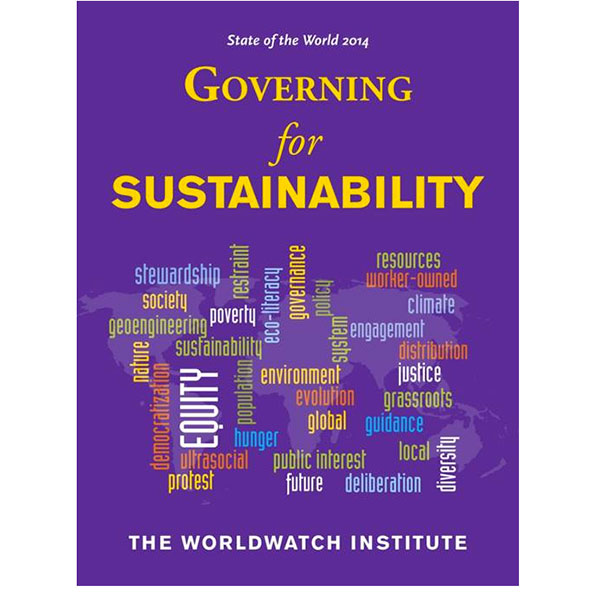
Author: The Worldwatch Institute (Island Press, 2014)
Books created by The WorldWatch Institute are always very intriguing. They balance on a very fine line between being excessively factual and containing just the right amount of emotional opinion. What this balance does is successfully bridge the gap where other books can fall short – playing to the academic or the layman. In this specific book, The WorldWatch Institute offered up some very powerful and clearly passionate articles by people from a variety of backgrounds. State of the World 2014: Governing for Sustainability takes a serious look at the political and economic factors that play into our journey towards reducing carbon emissions and preparing for a world where climate change becomes more apparent.
As I read through the book, I felt a similar connection with WorldWatch’s other yearly book, Vital Signs. But where Vital Signs had a more solid fact-based account of what was happening in the world, State of the World 2014 looks more at options and choices with respect to how the effects of climate changes will affect us – putting the knowledge and power in our hands.
The book is broken into two sections, Political Governance and Economic Governance. They may sound slightly dry but within is a wide and interesting diversity of works connected to their theme. For example, in an article titled Living in the Anthropocene: Business as Usual, or Compassionate Retreat, Peter G. Brown and Jeremy J. Schmidt look closely at our options of geoengineering, or what they call “compassionate retreat.” They explore the idea that geoengineering is simply a tool being discussed due to the fact that we have yet to really take the time to properly mitigate and prepare for the changes that will occur due to climate change. It is a “technozoic approach” as they put it.
Instead of running a “management-first approach,” the authors believe an “ethics-first approach” will suit us much better. Accordingly, we should start by “identifying the mistaken assumptions about human-environment relationships that brought on the climate crisis, and indeed the Anthropocene itself.”
It is statements like this that make State of the World 2014 stand apart from other books. There is a strong sense of change in the words: a real and tangible emotion evident in all of the authors. And when change is what they are asking for, not everything can be hard facts and numbers. The argument that Brown and Schmidt seem to make is that hard statistics are great, but if we aren’t seeing the world as a level playing field of ethical responsibility, how can we change?
As the book moves into the economic section, the emotion remains clearly apparent. Despite charts and graphs getting a little heavier, the fact remains that the articles have been curated appropriately for their message to be heard. Never did one article stifle another or disrupt my train of thought. It was as if all these authors had gathered together and had written this book over a conference. Not the case, I know, but that is just how well Tom Prugh and Michael Renner, the project directors, did at putting together this book. Its flow was never lacking: it was informative and factual (and slightly terrifying at times), while containing emotion. I had a similar experience with Vital Signs, but after getting over the fear, I felt a sense of purpose and clarity. Likewise with State of the World 2014: Governing for Sustainability.
That we have all the tools at our fingertips to drive successful change continues to be a recurring theme in books focusing on climate change. But this book explores a simple question: “How do we use them wisely?”
***
Jeremy Senko is happily lost in the world of theoretical architecture and design. He is forever a student at heart, consistently reading, experiencing and learning about the world he inhabits. More specifically, he recently completed his Bachelor of Interior Design at Kwantlen Polytechnic University, where he pushed the limits (and the patience) of his professors.

